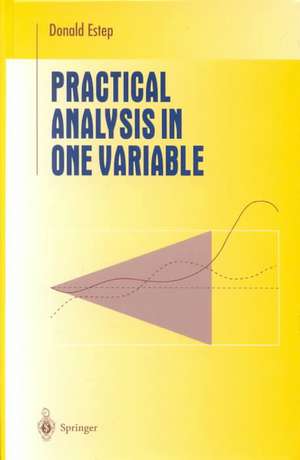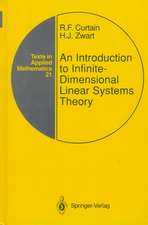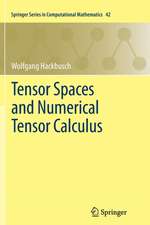Practical Analysis in One Variable: Undergraduate Texts in Mathematics
Autor Donald Estepen Limba Engleză Hardback – oct 2002
| Toate formatele și edițiile | Preț | Express |
|---|---|---|
| Paperback (1) | 474.56 lei 43-57 zile | |
| Springer – dec 2010 | 474.56 lei 43-57 zile | |
| Hardback (1) | 522.02 lei 43-57 zile | |
| Springer – oct 2002 | 522.02 lei 43-57 zile |
Din seria Undergraduate Texts in Mathematics
- 17%
 Preț: 362.13 lei
Preț: 362.13 lei - 17%
 Preț: 365.43 lei
Preț: 365.43 lei - 20%
 Preț: 466.84 lei
Preț: 466.84 lei - 17%
 Preț: 367.24 lei
Preț: 367.24 lei -
 Preț: 351.54 lei
Preț: 351.54 lei -
 Preț: 395.09 lei
Preț: 395.09 lei - 8%
 Preț: 384.89 lei
Preț: 384.89 lei -
 Preț: 306.96 lei
Preț: 306.96 lei -
 Preț: 380.27 lei
Preț: 380.27 lei -
 Preț: 400.43 lei
Preț: 400.43 lei -
 Preț: 358.11 lei
Preț: 358.11 lei -
 Preț: 372.27 lei
Preț: 372.27 lei -
 Preț: 400.43 lei
Preț: 400.43 lei -
 Preț: 364.41 lei
Preț: 364.41 lei - 17%
 Preț: 368.61 lei
Preț: 368.61 lei -
 Preț: 433.85 lei
Preț: 433.85 lei -
 Preț: 304.91 lei
Preț: 304.91 lei -
 Preț: 290.80 lei
Preț: 290.80 lei - 13%
 Preț: 389.61 lei
Preț: 389.61 lei - 17%
 Preț: 395.93 lei
Preț: 395.93 lei -
 Preț: 407.96 lei
Preț: 407.96 lei -
 Preț: 449.62 lei
Preț: 449.62 lei -
 Preț: 415.95 lei
Preț: 415.95 lei -
 Preț: 280.65 lei
Preț: 280.65 lei -
 Preț: 370.78 lei
Preț: 370.78 lei -
 Preț: 407.63 lei
Preț: 407.63 lei -
 Preț: 339.37 lei
Preț: 339.37 lei -
 Preț: 402.35 lei
Preț: 402.35 lei - 17%
 Preț: 373.60 lei
Preț: 373.60 lei -
 Preț: 398.78 lei
Preț: 398.78 lei -
 Preț: 440.01 lei
Preț: 440.01 lei -
 Preț: 424.14 lei
Preț: 424.14 lei - 17%
 Preț: 366.38 lei
Preț: 366.38 lei -
 Preț: 367.41 lei
Preț: 367.41 lei -
 Preț: 257.71 lei
Preț: 257.71 lei - 17%
 Preț: 362.67 lei
Preț: 362.67 lei - 15%
 Preț: 417.75 lei
Preț: 417.75 lei - 17%
 Preț: 366.40 lei
Preț: 366.40 lei - 19%
 Preț: 400.52 lei
Preț: 400.52 lei -
 Preț: 298.01 lei
Preț: 298.01 lei -
 Preț: 329.95 lei
Preț: 329.95 lei - 19%
 Preț: 492.83 lei
Preț: 492.83 lei -
 Preț: 396.24 lei
Preț: 396.24 lei -
 Preț: 390.08 lei
Preț: 390.08 lei
Preț: 522.02 lei
Preț vechi: 614.13 lei
-15% Nou
Puncte Express: 783
Preț estimativ în valută:
99.92€ • 108.57$ • 83.99£
99.92€ • 108.57$ • 83.99£
Carte tipărită la comandă
Livrare economică 21 aprilie-05 mai
Preluare comenzi: 021 569.72.76
Specificații
ISBN-13: 9780387954844
ISBN-10: 0387954848
Pagini: 623
Ilustrații: XX, 623 p.
Dimensiuni: 155 x 235 x 34 mm
Greutate: 1.05 kg
Ediția:2002
Editura: Springer
Colecția Springer
Seria Undergraduate Texts in Mathematics
Locul publicării:New York, NY, United States
ISBN-10: 0387954848
Pagini: 623
Ilustrații: XX, 623 p.
Dimensiuni: 155 x 235 x 34 mm
Greutate: 1.05 kg
Ediția:2002
Editura: Springer
Colecția Springer
Seria Undergraduate Texts in Mathematics
Locul publicării:New York, NY, United States
Public țintă
Lower undergraduateCuprins
Numbers and Functions, Sequences and Limits.- Mathematical Modeling.- Natural Numbers Just Aren’t Enough.- Infinity and Mathematical Induction.- Rational Numbers.- Functions.- Polynomials.- Functions, Functions, and More Functions.- Lipschitz Continuity.- Sequences and Limits.- Solving the Muddy Yard Model.- Real Numbers.- Functions of Real Numbers.- The Bisection Algorithm.- Inverse Functions.- Fixed Points and Contraction Maps.- Differential and Integral Calculus.- The Linearization of a Function at a Point.- Analyzing the Behavior of a Population Model.- Interpretations of the Derivative.- Differentiability on Intervals.- Useful Properties of the Derivative.- The Mean Value Theorem.- Derivatives of Inverse Functions.- Modeling with Differential Equations.- Antidifferentiation.- Integration.- Properties of the Integral.- Applications of the Integral.- Rocket Propulsion and the Logarithm.- Constant Relative Rate of Change and the Exponential.- A Mass-Spring System and the Trigonometric Functions.- Fixed Point Iteration and Newton’s Method.- Calculus Quagmires.- You Want Analysis? We’ve Got Your Analysis Right Here.- Notions of Continuity and Differentiability.- Sequences of Functions.- Relaxing Integration.- Delicate Limits and Gross Behavior.- The Weierstrass Approximation Theorem.- The Taylor Polynomial.- Polynomial Interpolation.- Nonlinear Differential Equations.- The Picard Iteration.- The Forward Euler Method.
Recenzii
From the reviews:
MAA ONLINE
"I confess that when I first started reading this book I was intrigued by the new approach of real analysis but did not quite see what it might be good for. In the end, however, I was convinced that it could be a very good textbook, especially in courses taken mostly by engineering majors: I am sure these students would find the approach to the book attractive and motivating."
D. Estep
Practical Analysis in One Variable
"A very good textbook, especially in courses taken mostly by engineering majors: I am sure these students would find the approach to the book attractive and motivating."—MAA ONLINE
"The author attempts to place in this book the basic ideas of real analysis and numerical analysis together in an applied setting that is both accessible and motivational to beginners. The book, not written in the widespread ‘theorem-proof’ style common in most mathematical textbooks, includes a lot of background and review material, numerous examples, visualizations and alternate explanations of some key ideas, and a big variety of exercises." (Peter Bundschuh, Zentralblatt MATH, Vol. 1038 (13), 2004)
"This book comes from a live human being, not from a publisher’s marketing group. … Estep has a very radical philosophy of teaching. For each topic, he frankly tells the reader why we want to do this, why we need to do it this way, and then he actually does it! Completely, correctly, and readably! … For the reader who wants to teach himself analysis, I can think of no better book for self study." (Reuben Hersh, SIAM Review, Vol. 45 (2), 2003)
"Estep combines the basic ideas of real analysis and numerical analysis in an applied framework. This framework is beautifully presented in the context of a fundamental approach to applied mathematical problem solving … . The book is written in an engaging manner … . Background and reviewmaterial and numerous examples … are provided in a very appealing manner. Abstract concepts are carefully explained and supported with a wealth of examples and illustrations … . Summing Up: Highly recommended." (D. E. Bentil, CHOICE, July, 2003)
"The book contains most of the classical topics in real analysis, but they are presented in the context of approximating solutions of physical models, a fundamental problem in applied mathematics. … I was convinced that it could be a very good text book, especially in courses taken mostly by engineering majors: I am sure these students will find the approach of the book attractive and motivating." (Mihaela Poplicher, MAA Online, July, 2003)
"This book is intended either for an honors calculus sequence or for the first real analysis course for mathematics majors who have completed the calculus sequence. … There is an abundance of exercises ranging from simple computations to estimates to computational projects. There is emphasis on providing explanation in solutions, and some exercises call for proofs of theorems. It should be an interesting book for either of the intended uses." (G. A. Heuer, Mathematical Reviews, 2003 h)
"The book includes background and review material, numerous examples, visualizations and alternate explanations of some key ideas, and a variety of exercises ranging from simple computations to analysis and estimates to computations on a computer. The book is thought for an honors calculus sequence typically taken by first-year undergraduates planning to major in engineering, mathematics, and science and for an introductory course in rigorous real analysis offered to mathematics majors." (Zentralblatt für Didaktik der Mathematik, Issue 1, 2003)
MAA ONLINE
"I confess that when I first started reading this book I was intrigued by the new approach of real analysis but did not quite see what it might be good for. In the end, however, I was convinced that it could be a very good textbook, especially in courses taken mostly by engineering majors: I am sure these students would find the approach to the book attractive and motivating."
D. Estep
Practical Analysis in One Variable
"A very good textbook, especially in courses taken mostly by engineering majors: I am sure these students would find the approach to the book attractive and motivating."—MAA ONLINE
"The author attempts to place in this book the basic ideas of real analysis and numerical analysis together in an applied setting that is both accessible and motivational to beginners. The book, not written in the widespread ‘theorem-proof’ style common in most mathematical textbooks, includes a lot of background and review material, numerous examples, visualizations and alternate explanations of some key ideas, and a big variety of exercises." (Peter Bundschuh, Zentralblatt MATH, Vol. 1038 (13), 2004)
"This book comes from a live human being, not from a publisher’s marketing group. … Estep has a very radical philosophy of teaching. For each topic, he frankly tells the reader why we want to do this, why we need to do it this way, and then he actually does it! Completely, correctly, and readably! … For the reader who wants to teach himself analysis, I can think of no better book for self study." (Reuben Hersh, SIAM Review, Vol. 45 (2), 2003)
"Estep combines the basic ideas of real analysis and numerical analysis in an applied framework. This framework is beautifully presented in the context of a fundamental approach to applied mathematical problem solving … . The book is written in an engaging manner … . Background and reviewmaterial and numerous examples … are provided in a very appealing manner. Abstract concepts are carefully explained and supported with a wealth of examples and illustrations … . Summing Up: Highly recommended." (D. E. Bentil, CHOICE, July, 2003)
"The book contains most of the classical topics in real analysis, but they are presented in the context of approximating solutions of physical models, a fundamental problem in applied mathematics. … I was convinced that it could be a very good text book, especially in courses taken mostly by engineering majors: I am sure these students will find the approach of the book attractive and motivating." (Mihaela Poplicher, MAA Online, July, 2003)
"This book is intended either for an honors calculus sequence or for the first real analysis course for mathematics majors who have completed the calculus sequence. … There is an abundance of exercises ranging from simple computations to estimates to computational projects. There is emphasis on providing explanation in solutions, and some exercises call for proofs of theorems. It should be an interesting book for either of the intended uses." (G. A. Heuer, Mathematical Reviews, 2003 h)
"The book includes background and review material, numerous examples, visualizations and alternate explanations of some key ideas, and a variety of exercises ranging from simple computations to analysis and estimates to computations on a computer. The book is thought for an honors calculus sequence typically taken by first-year undergraduates planning to major in engineering, mathematics, and science and for an introductory course in rigorous real analysis offered to mathematics majors." (Zentralblatt für Didaktik der Mathematik, Issue 1, 2003)
Textul de pe ultima copertă
This book attempts to place the basic ideas of real analysis and numerical analysis together in an applied setting that is both accessible and motivational to young students. The essentials of real analysis are presented in the context of a fundamental problem of applied mathematics, which is to approximate the solution of a physical model. The framework of existence, uniqueness, and methods to approximate solutions of model equations is sufficiently broad to introduce and motivate all the basic ideas of real analysis. The book includes background and review material, numerous examples, visualizations and alternate explanations of some key ideas, and a variety of exercises ranging from simple computations to analysis and estimates to computations on a computer. The book can be used in an honor calculus sequence typically taken by freshmen planning to major in engineering, mathematics, and science, or in an introductory course in rigorous real analysis offered to mathematics majors.
Donald Estep is Professor of Mathematics at Colorado State University. He is the author of Computational Differential Equations, with K. Eriksson, P. Hansbo and C. Johnson (Cambridge University Press 1996) and Estimating the Error of Numerical Solutions of Systems of Nonlinear Reaction-Diffusion Equations with M. Larson and R. Williams (A.M.S. Memoirs, 2000), and recently co-edited Collected Lectures on the Preservation of Stability under Discretization, with Simon Tavener (S.I.A.M., 2002), as well as numerous research articles. His research interests include computational error estimation and adaptive finite element methods, numerical solution of evolutionary problems, and computational investigation of physical models.
Donald Estep is Professor of Mathematics at Colorado State University. He is the author of Computational Differential Equations, with K. Eriksson, P. Hansbo and C. Johnson (Cambridge University Press 1996) and Estimating the Error of Numerical Solutions of Systems of Nonlinear Reaction-Diffusion Equations with M. Larson and R. Williams (A.M.S. Memoirs, 2000), and recently co-edited Collected Lectures on the Preservation of Stability under Discretization, with Simon Tavener (S.I.A.M., 2002), as well as numerous research articles. His research interests include computational error estimation and adaptive finite element methods, numerical solution of evolutionary problems, and computational investigation of physical models.
Caracteristici
Includes supplementary material: sn.pub/extras













